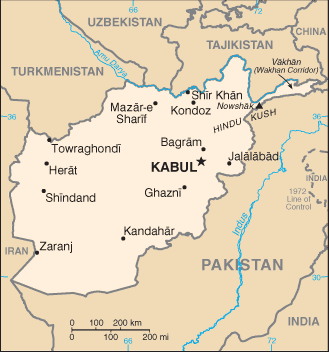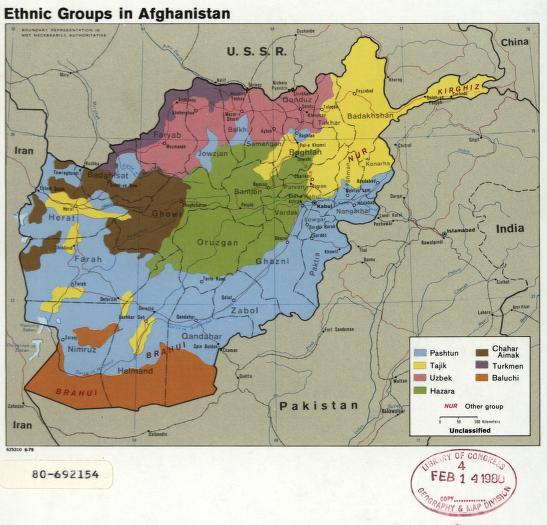11.4: Afghan-Soviet War- 1979-89
- Page ID
- 154882
What Led to the Soviet Invasion of Afghanistan?
Afghanistan is a landlocked nation that is ethnically diverse, and strategically located at the crossroads of Asia and the Middle East. As seen in the map in Figure 11.4.1, Afghanistan shares a border with Pakistan in the south and east; in the west it shares a border with Iran; in the north it shares borders with Turkmenistan, Uzbekistan, and Tajikistan; in the northeast, it shares a border with China. Kabul is the capital and largest city in Afghanistan. The population of Afghanistan is multiethnic and multilingual. The map in Figure 11.4.2 shows the Afghan ethnic groups, which include Pashtun, Tajik, Hazara, Uzbek as well as smaller groups such as Aimak, Turkmen, and Baluchi. After the defeat of the British in the Anglo-Afghan Wars, Afghanistan became an independent nation, and a constitutional monarchy was established in 1926. During World War II, the Kingdom of Afghanistan, ruled by Zahir Shah, remained neutral and pursued a diplomatic policy of nonalignment. In 1964, King Zahir Shah permitted the growth of political parties that included the communist People’s Democratic Party of Afghanistan (PDPA). In 1967, the PDPA, which had close ties to the Soviet Union, split into two rival factions: the Khalq (Masses), headed by Nur Mohammad Taraki and Hafizullah Amin; and the Parcham, headed by Babrak Karmal.

Figure \(\PageIndex{1}\): Map of Afghanistan, CIA World Factbook, in the Public Domain.

Figure \(\PageIndex{2}\): Ethnic Groups in Afghanistan, Library of Congress, in the Public Domain.
In 1973, while King Zahir Shah was receiving medical treatment in Italy, his cousin Mohammad Daoud Khan seized power through a nonviolent coup, abolished the monarchy and declared Afghanistan a republic. Mohammad Daoud Khan declared himself as the first president and prime minister of the new Republic of Afghanistan. Daoud Khan failed to carry out the badly needed social and economic reforms. In 1978, the government killed a prominent member of the PDPA and arrested several leaders of the PDPA. In response, Hafizullah Amin, Babrak Karmal, Nur Mohammad Taraki and other leaders of the PDPA who managed to remain at large organized a coup, assassinated Daoud Khan along with his family, and overthrew the government in April 1978. This bloody coup became known as the Saur Revolution. Taraki became the head of government and General Secretary of the PDPA and controlled the army. Hafizullah Amin took over as the prime minister. The country was renamed as the Democratic Republic of Afghanistan. Although the Afghan people revolted against the PDPA government and their socialist land reforms, the PDPA lasted in power in some form until 1992. In March 1979, Taraki was overthrown and killed. Hafizullah Amin named himself the chairman of the Revolutionary Council (head of state) and General Secretary of the PDPA (supreme leader). The Soviets were not in favor of seeing Hafizullah Amin as the leader of the PDPA because he sought to reduce Afghan dependence on the Soviet Union. The Politburo had also opposed the removal of Taraki. In December 1979 the Soviet Union invaded Afghanistan with the help of the Parcham faction and took complete political and military control of Afghanistan. Hafizullah Amin was killed along with his family and the Soviets installed Babrak Karmal as the new General Secretary of Afghanistan in 1980.
The Soviet invasion of Afghanistan in 1979 triggered a conflict between the United States and the Soviet Union in Afghanistan. Soviet invasion was also met with widespread opposition from the Afghan people, who viewed it as an unwarranted act of aggression by a foreign power. Afghan resistance to Soviet occupation was fueled by a strong sense of nationalism, desire for self-determination, and anti-communism. The Soviets used brutal tactics, such as bombing and killing civilians, and never won the support of the Afghan people. The Mujahideen were a loosely organized coalition of Afghan rebels, mostly Pashtun, who fought against Soviet forces. They gained popular support by positioning themselves as defenders of anti-communist Afghan national sovereignty. In addition to their military activities, the Mujahideen also provided several social services, such as food distribution and healthcare, to poor people to gain loyalty and frame their struggle as a holy war against the cruel invaders. Figure 11.4.3 is a photo of a White House meeting of Mujahideen leaders with President Reagan in 1983. The Reagan Administration extended support to the Mujahideen because it was an anti-communist resistance group. President Reagan is dressed in a suit. There are five male leaders are wearing turbans and the traditional peraahan tunbaan and seated on either side of the US president. One female Afghan is seen wearing a head scarf and long dark coat.

What Led to Soviet Withdrawal in 1989?
President Carter wrote a sharply worded letter to Premier Brezhnev denouncing Soviet aggression. In response to the Soviet invasion, the Carter administration began arming the Afghan resistance movement. The Carter administration also enacted economic sanctions and trade embargoes against the Soviet Union, called for a boycott of the 1980 Moscow Olympics, and stepped up its aid to the Afghan insurgents. The Reagan Administration inherited an active program that supplied covert military aid to the Mujahideen, which included the support of intelligence services of the UK, Saudi Arabia, Egypt, Pakistan, and China. This coordinated effort eventually led to Gorbachev’s decision to end the war and withdraw from Afghanistan in 1989. The huge financial burden coupled with the massive loss of lives made the war unsustainable for the Soviets and eventually contributed to the collapse of the USSR itself in 1991. Overall, the war in Afghanistan contributed to a sense of disillusionment and weakness within the USSR, which undermined the government’s ability to maintain control and ultimately contributed to the collapse of the USSR. The collapse of the Soviet Union in 1991 was one of the biggest historic events of the twentieth century. The breakdown of the USSR was due to an aggregate of factors, some internal, and some foreign. However, among the many reasons for the fall of the Union, the invasion of Afghanistan was a contributing factor. The war in Afghanistan was the longest war in which Soviet troops were involved. The Soviets were also not familiar with Afghan culture and society, both of which proved very difficult for the Soviets to deal with.
During the last four years of the war in Afghanistan, there was a profound break in Soviet establishments. The gap between the government and society was the main conflict. The non-Russian population of the Soviet Empire feared from the Soviet government and didn’t trust them when their livelihoods were in jeopardy. The financial crisis of the USSR, the debilitated separation of the Soviet Union into independent republics, and a debilitating of its military security demonstrated that the Soviet could no longer afford to keep pace with the military expenditure of the United States. The withdrawal of the Soviets from Afghanistan sent a message to other Soviet regions that Moscow would not be a solid accomplice in other Soviet-impacted nations. During the Cold War the Soviets constantly preached that they were supporting the developing countries to maintain their freedom. However, when the USSR invaded Afghanistan, people found that Russia was not a reliable ally. If the Soviets invaded Afghanistan, they could invade any other country as well. The occupation of Afghanistan caused irreversible internal conflicts between the Soviet republics and the Soviet government. By 1985, when Mikhail Gorbachev took the position of general secretary in the Community Party, Soviet economic and military resources had been heavily drained.
In Afghanistan, a civil war broke out after the Soviets withdrew. The Taliban, an Islamic fundamentalist group supported by Pakistan, seized control of Afghanistan, and later provided Osama bin Laden with a training base from which to launch terrorist operations worldwide during the 1990s, the US took a back seat in Afghanistan. After the 9/11 terrorist attacks in 2001 the US invaded Afghanistan and remained there for two decades. The US invasion ended the reign of the Taliban. In November 2001 the United States and representatives of regional powers, most notably Iran and Russia, selected Hamid Karzai as President of the Transitional Administration of Afghanistan. Subsequently, the traditional Afghan procedure of Loya Jirga was employed to choose the President, and a US-style constitution was promulgated. This was followed by a presidential election in 2004, and the election of the Parliament. In 2022, during the presidency of Joe Biden, the US finally pulled American troops out of Afghanistan.
- Why did the Soviet Union invade Afghanistan?
- Why were most Afghans opposed to communist rule in their country?

